Given all the ways dance mattered, socially and personally, during the Regency, it’s obvious that acquiring the skills and training to dance well (along with the proper etiquette) was supremely important. Skills on the dance floor would not entirely make or break a young person’s future, but they certainly helped.
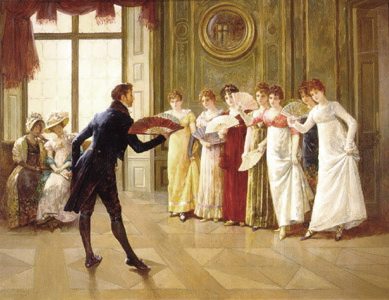
Young ladies and gentlemen of wealthy families would usually receive private tutoring from a professional Dance Master. These men would be hired by multiple families and would travel from house to house to teach the latest dances as well as proper steps, comportment, posture, and behavior.
I’m certain there was snobbery over just which dance master your household had hired! One who was French and had references from higher ranked families, or one who was well-known among the ton and had published extensively, would certainly be preferred over a relatively unknown candidate.
How their pupils felt about them probably varied not only by how well they taught, but also by their age, personality and personal appearance, and the ages of the young people they taught. I can imagine young ladies developing a crush on their dance instructor if he was a bit charming, but I also imagine the young girl you can see in the back of the Cruikshank cartoon below thinking very un-ladylike thoughts about hers while forced to stand in the “hip-turner” box (also known as turn-out boards, or the torture box).
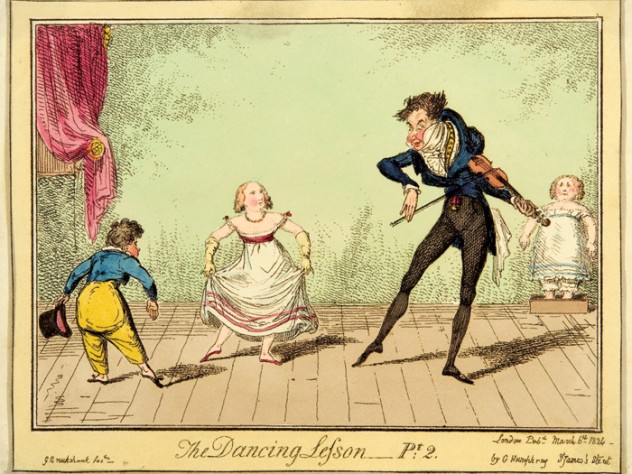
It was more properly called a tourne hanche, which betrays its French origins. Its purpose was to train the feet to turn outward at a wide angle, a ballet-like position you can see the others in this scene all maintain. The small, easily portable violin played by the dancing master is not an exaggeration by the cartoonist –it is called a pochette, or “pocket violin.”
The less wealthy could take classes at a dance academy (in a large enough town), just as one might do today. Dance Masters strove for prominence through publishing as well as through the success of their competing establishments. Given a basic understanding of the main forms of dances, one could purchase the latest books, which usually included the instructions for performing each dance. Publications such as “Thompson’s 24 Country Dances for the Year 1802” came out every year with new dances. The selection would vary depending on who issued the publication. The most popular dances might be carried over from year-to-year for a very long time, while some new ones might be introduced to be danced to old familiar tunes.
The most prominent dance masters competed with each other, trying to out-do each other with their offerings and credentials. In the 1820’s, established master Thomas Wilson and relative newcomer George Chivers engaged in an infamous rivalry. A typical advertisement from The Morning Post (13th November, 1818) reads:
Waltzing, Ecossoises, Quadrilles, Spanish Dancing, Minuets, La Grand Polonaise, Gavottes, Country Dances, Swedish Dancing &c — Mr CHIVERS, late of the King’s Theatre Italian Opera House, gives PUBLIC or PRIVATE LESSONS and PRACTICE in the EVENING, from Eight till Ten, or Nine till Eleven, or any hour of the day, MONDAYS, WEDNESDAYS, and FRIDAYS. Mrs Chivers superintends the ladies in a separate apartment. Families attended. Professors taught any department, and the greatest secrecy observed. Cards had at Mr Chivers’ Academy and Assembly Rooms, No 7 Pickett-Place, Temple bar; where may be had A Companion to the French and English Dancing, also the Swedish Dances (which Mr C. has introduced into this country; its simplicity and elegance surpasses all others, and is well adapted to parties having a majority of either sex.) The Rooms may be had occasionally, which have accommodation for 200 persons.
Chivers’s establishment shared space with a Fencing Master, also a fairly typical arrangement, but one that pressed limitations on scheduling classes. I fancy a resemblance between Cruikshank’s dance master in many of his later cartoons and Chivers’s portrait from one of his own publications, although I’ve found no reference that this was intentional.
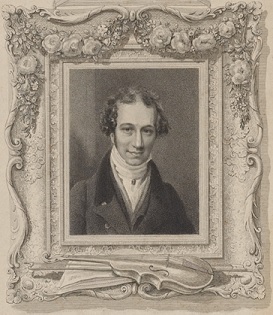
Trained older siblings could be pressed into duty to teach the younger family members when circumstances demanded economy. Dance would be among the subjects taught at finishing schools for young ladies and academies for young gentlemen. This lovely Hugh Thompson illustration is from a story (“Quality Street”) about sisters who start such a school.
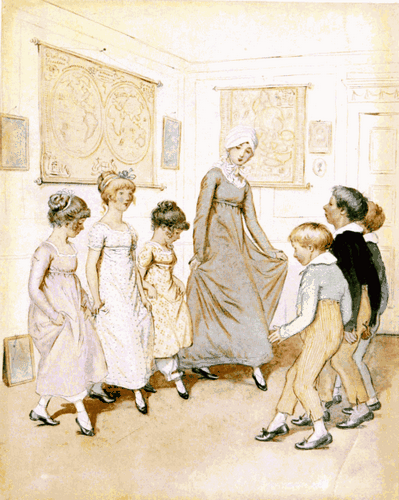
Nor should we discount the role of observation, as anyone attending an assembly or ball could watch others to study the figures (sets of steps) of any dance one didn’t know. English country dances dominated during the early Regency years. They are fairly easy, once you have learned a “vocabulary” of the various figures, which appear over and over again in different combinations for each dance. So learning the order in which they are done for a particular dance would not be too hard.
Becoming proficient at the steps, however, could be more problematic. Regency dancing is energetic, the steps precise. The “walking” steps that many modern country dancers use were not the thing at all in period.
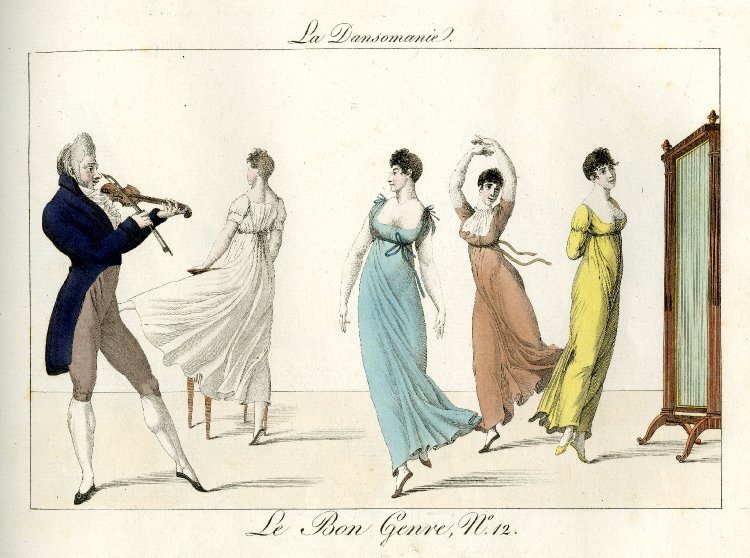
Dance footwork in the Regency era, even for country dances, was closer to ballet. Jane Austen wrote of Fanny in Mansfield Park, “Sir Thomas, having seen her walk rather than dance down the shortening set, breathless, and with her hand at her side, gave his orders for her sitting down entirely.” Posture, deportment, and above all, elegance, were required.
Do you wonder if you would forget how to do one of the dances at a ball? You would not be alone. Many dancers needed a way to “crib”! How about carrying a fan with the latest dances printed on it? Or a discrete set of cards with the instructions, strung on a ribbon around your wrist or tucked into your reticule? Here are pictures of some of these period “memory aides” for dancing (helpfully offered for sale by the dance masters)!
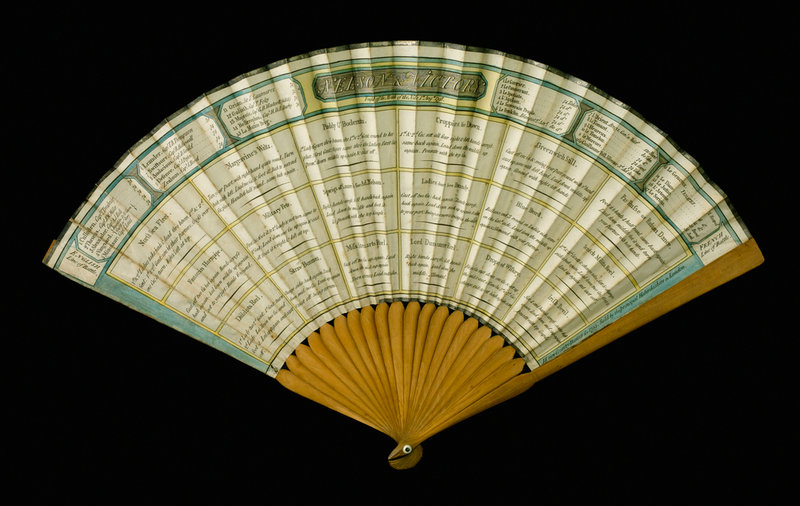
1799 fan “Nelson & Victory”, printed with dances and short notes on the figures of each.

The dances on this fan are:
• Captain Mc Lean – Whim of the Moment – Duke of
Clarences Fancy – Dreary Dun
• Paynes Jigg – Miss Dukes Fancy – The Fife Hunt – The
Birth day – Dibdins Fancy – Garthland
• Sir Alexander Dons – Ballata Waltz – Jem of
Aberdeen Waltz – The Harriot -The Highland Club
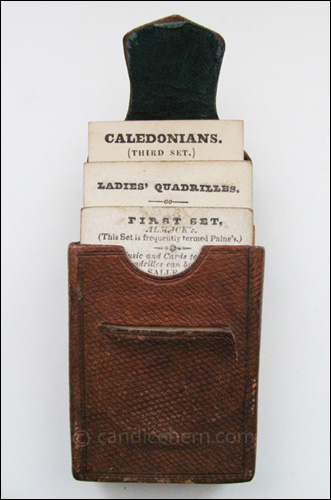
Example of printed instruction cards (1828?) in a leather case, from Candace Hern’s fabulous collection of Regency things. If you haven’t seen her website, I recommend a visit! https://candicehern.com/regencyworld/dance-instruction-cards/
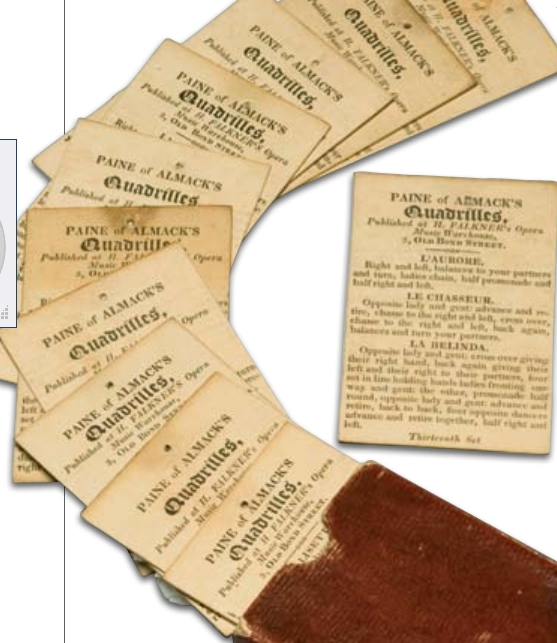
A similar set of cards in The Harvard Library’s Ward Theater Collection, designed to be threaded on ribbon and worn around the wrist, printed with dance instructions for the quadrille, 1815. Selling sets of such cards were yet another way the enterprising dance masters tried to earn their bread.
Speaking of dance cards, what about those little ones with a pencil with which you could write in your partners names? Did they have those in the Regency era?
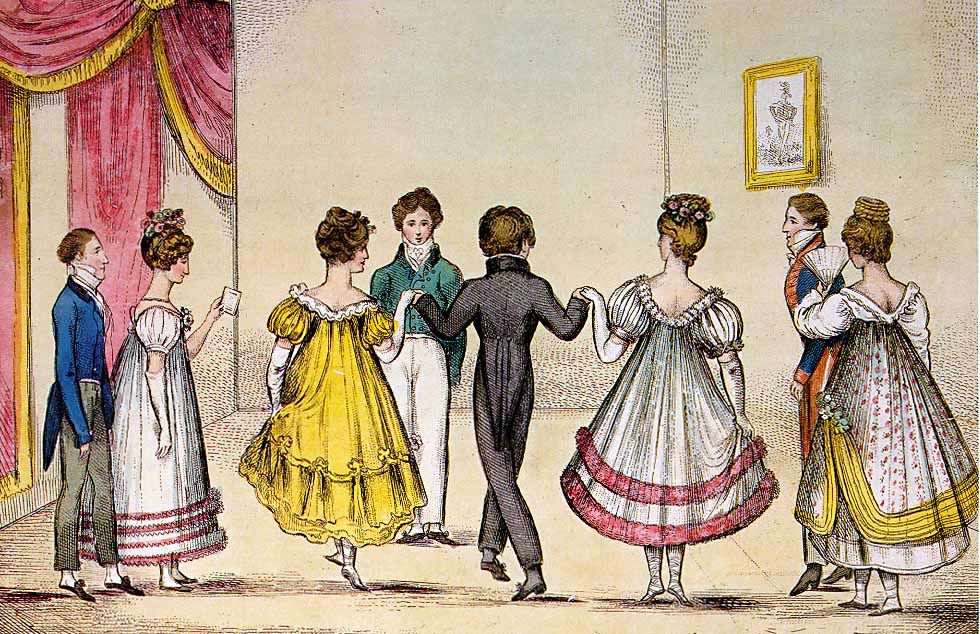
In this 1820’s image of Quadrille dancers, one of the “waiting” women (at left) is clearly looking at her dance card. Is it to see what other dances are planned and to whom she has promised them? (She’s with her current partner -how rude that would be!)
The term “dance card” in English with the latter meaning is dated 1892 by the Oxford English Dictionary –well past the Regency and even Victorian eras. It’s a beloved tradition with authors and I may have even had this wrong in some of my early books, but the answer is: NO. Prompt cards to tell the dances, yes, but not to write in the names of partners, not until much later in the 19th century. For one thing, tiny pencils were not yet being made! And pens required an inkwell. But here’s an example of one from the 1880’s, and a fun collection of such cards, dating 1913-1940’s, if you’re interested!! http://gettysburg.cdmhost.com/…/collecti…/p16274coll9/search
I hope you’ve enjoyed this series. Dance history is one of my great loves! If you have questions, I will be happy to try to answer them in the comments. Parts 1-3 of this series, if you missed them, can be found posted in previous weeks during July.
